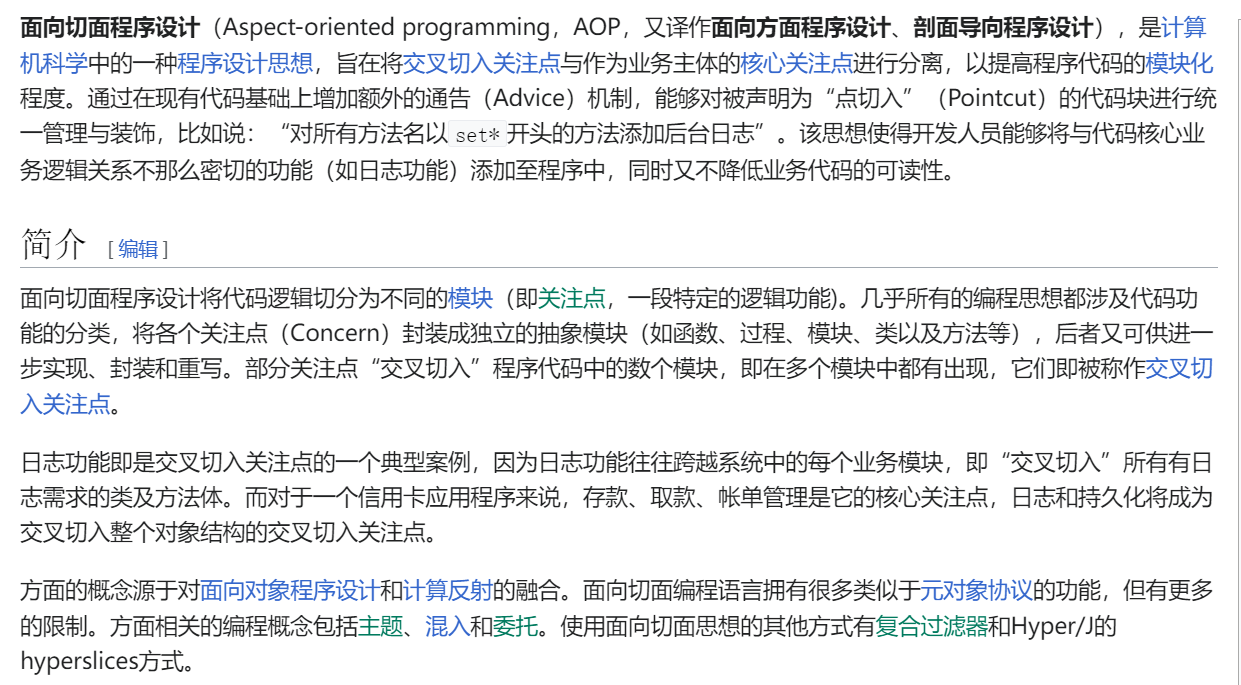什么是AOP?
维基百科介绍

我的理解
什么是
AOP?
简单来说,AOP就是为了更加优雅的编写业务、专注于业务开发、增加代码可读性,将一些具有某种功能的代码抽取出来,然后通过Spring AOP注解的形式注入使用。
怎么实现?
AOP的相关注解:
| 注解 | 含义 |
|---|---|
| @Aspect | 定义切面类 |
| @Pointcut | 定义切入点,表示在哪些连接点上切入执行增强操作 |
| @Before | 表示在目标方法执行之前执行增强操作 |
| @After | 表示在目标方法执行之后(无论是否发生异常)执行增强操作 |
| @AfterReturning | 在目标方法执行之后(正常返回时)执行增强操作 |
| @AfterThrowing | 在目标方法执行之后(发生异常时)执行增强操作 |
| @Around | 包围目标方法,可以在执行前后自定义增强操作 |
| @DeclareParents | 引入新的接口到目标对象 |
这些注解可以与其他Spring注解一起使用,例如
@Component、@Service、@Controller等,以实现对特定方法或类的增强操作。通过使用这些注解,您可以在不修改原始代码的情况下,将横切关注点(例如日志记录、事务管理等)模块化地应用到应用程序中的不同部分。
实例:
假设我们有一个
UserService接口和一个UserServiceImpl类,现在我们想要在createUser方法执行前后添加日志记录的功能。public interface UserService { void createUser(String username, String password); } public class UserServiceImpl implements UserService { public void createUser(String username, String password) { // 创建用户的实现逻辑 } }创建一个切面类,并在切面类的方法上使用
@Around注解来定义环绕通知:@Aspect @Component public class LoggingAspect { private static final Logger logger = LoggerFactory.getLogger(LoggingAspect.class); @Around("execution(* com.example.service.UserService.createUser(..))") public Object logMethodExecution(ProceedingJoinPoint joinPoint) throws Throwable { String methodName = joinPoint.getSignature().getName(); logger.info("Executing method: {}", methodName); // 执行目标方法 Object result = joinPoint.proceed(); logger.info("Method {} executed successfully", methodName); return result; } }
知识扩展
这行代码怎么理解?
execution(* com.example.service.*.*(..))
execution(* com.example.service.*.*(..)) 是一个切入点表达式(Pointcut Expression),它用于指定切入点的位置。
切入点表达式由以下几部分组成:
execution: 指定切入点类型为方法执行。*: 匹配任意返回类型的方法。com.example.service: 指定目标方法所在的包路径。*.*: 第一个*表示任意类名,第二个*表示任意方法名。(..): 匹配任意参数类型和数量的方法参数。
所以,execution(* com.example.service.*.*(..)) 表示匹配 com.example.service 包下任意类的任意方法,并且方法的参数可以是任意类型和数量。
实际业务中经常使用
AOP的示例:日志记录和事务管理的结合
import org.aspectj.lang.JoinPoint;
import org.aspectj.lang.annotation.AfterReturning;
import org.aspectj.lang.annotation.Aspect;
import org.aspectj.lang.annotation.Before;
import org.slf4j.Logger;
import org.slf4j.LoggerFactory;
import org.springframework.stereotype.Component;
import org.springframework.transaction.annotation.Transactional;
@Aspect
@Component
public class LoggingAndTransactionalAspect {
private static final Logger logger = LoggerFactory.getLogger(LoggingAndTransactionalAspect.class);
@Before("execution(* com.example.service.*.*(..))")
public void logBefore(JoinPoint joinPoint) {
String methodName = joinPoint.getSignature().getName();
String className = joinPoint.getTarget().getClass().getSimpleName();
logger.info("Executing method {} in class {}", methodName, className);
}
@AfterReturning(value = "execution(* com.example.service.*.*(..))", returning = "result")
@Transactional
public void logAfterReturning(JoinPoint joinPoint, Object result) {
String methodName = joinPoint.getSignature().getName();
String className = joinPoint.getTarget().getClass().getSimpleName();
logger.info("Method {} in class {} executed successfully. Result: {}", methodName, className, result);
}
}
增加了@Transactional注解。这意味着在目标方法执行后,会自动开启事务并提交事务。这样,我们就实现了日志记录和事务管理的结合。